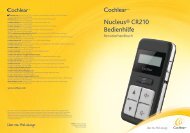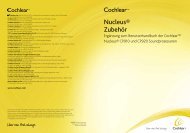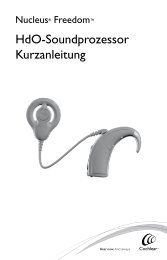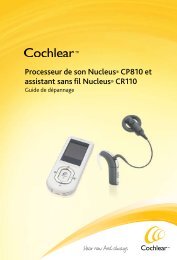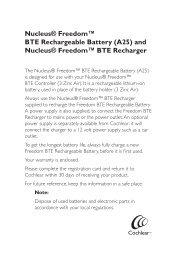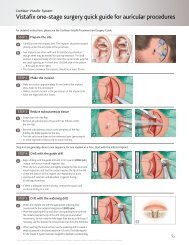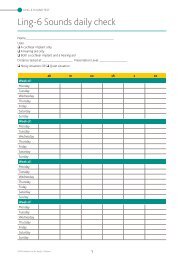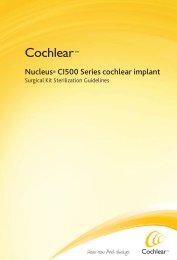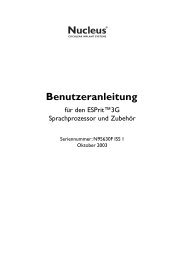Baha Candidate Selection Guide (2.3 MB) - Cochlear
Baha Candidate Selection Guide (2.3 MB) - Cochlear
Baha Candidate Selection Guide (2.3 MB) - Cochlear
Create successful ePaper yourself
Turn your PDF publications into a flip-book with our unique Google optimized e-Paper software.
<strong>Candidate</strong> <strong>Selection</strong> <strong>Guide</strong>
Products in this manual are protected by the following patents: US 5 735 790, US 5 7 935 170, EP 0715839, EP 0715838 and<br />
corresponding patents in other countries and pending patent applications. All products can be subject to change without notice.<br />
No part of this publication may be replaced, stored in a retrieval system, or transmitted in any form, by electronic, mechanical,<br />
photocopying, recording, or other means, without the prior written permission of the publisher.<br />
Caution: Federal law (USA) restricts this device to sale by or on the order of a medical practitioner.<br />
© <strong>Cochlear</strong> 2009<br />
Cover image: <strong>Baha</strong> Intenso, table of contents image: Test rods
Contents<br />
4 Introduction<br />
6 PART 1: Identifying candidates<br />
11 PART 2: <strong>Candidate</strong> evaluation<br />
14 PART 3: Counselling<br />
17 PART 4: Paediatric candidacy<br />
20 Appendix 1: Device considerations<br />
23 Appendix 2: Case histories<br />
28 Appendix 3: Clinical results<br />
29 References
Introduction<br />
4
Introduction<br />
This <strong>Candidate</strong> <strong>Selection</strong> <strong>Guide</strong> provides detailed<br />
information on how to select candidates who will benefit<br />
from <strong>Baha</strong> ® . With bone conduction, sound bypasses the<br />
outer and middle ear, and goes directly to the inner ear. <strong>Baha</strong><br />
is an effective implantable hearing solution for people with<br />
conductive hearing loss, mixed hearing loss, or single-sided<br />
sensorineural deafness (SSD). The <strong>Baha</strong> system works by<br />
enhancing natural bone conducted sound.<br />
The advantages of <strong>Baha</strong><br />
The main advantage of <strong>Baha</strong> is that it bypasses the conductive element of a hearing loss through<br />
direct bone conduction and only needs to compensate for the sensorineural element.<br />
Therefore, for conductive or mixed hearing loss with an air-bone gap >30 dB, measured at<br />
500, 1000, 2000, and 4000 Hz (PTA 4 ), <strong>Baha</strong> should be the amplification method of choice. 1–6<br />
When worn on the deaf side, the <strong>Baha</strong> device transfers sound directly to the healthy cochlea,<br />
which eliminates head shadow effect, enables 360˚ sound awareness, and improves speech<br />
understanding in noise. 7,8,9<br />
There are also several medical indications where <strong>Baha</strong> could be the best solution for the<br />
candidate. Read more about this on page 11.<br />
Getting <strong>Baha</strong> for your candidate<br />
When you have identified a candidate for <strong>Baha</strong>, the candidate will need to be referred<br />
to an ENT surgeon for consultation. <strong>Candidate</strong>s considered suitable for surgery will then<br />
have a small titanium implant placed in the mastoid bone behind their ear.<br />
The <strong>Baha</strong> system consists of a high-performance sound processor, an abutment and a titanium<br />
implant which is located in the bone behind your ear. The surgical procedure may be performed<br />
under a local anaesthetic and is generally regarded as minor surgery from both the surgeon’s<br />
and candidate’s point of view. The <strong>Baha</strong> sound processor is easily connected and disconnected<br />
once the implant has fused with the bone (a process known as osseointegration).<br />
Advantages of <strong>Baha</strong><br />
Compared to conventional<br />
air conduction (AC) hearing aids:<br />
• Less need for amplification<br />
- because the conductive element<br />
of the hearing loss is bypassed<br />
• No occlusion of the ear canal. 10,11<br />
Compared to middle ear surgery:<br />
• Safe and reliable means<br />
of restoring hearing<br />
• A reversible intervention<br />
• No risk of additional<br />
hearing impairment<br />
• The <strong>Baha</strong> sound processor can<br />
be evaluated prior to surgery.<br />
Introduction<br />
5
PART 1: Identifying candidates<br />
6<br />
PART 1: Identifying candidates<br />
There are three main audiological indications for <strong>Baha</strong> ® :<br />
• Conductive hearing loss<br />
• Mixed hearing loss<br />
• Single-sided sensorineural deafness (SSD)<br />
For each type of hearing loss there are specific criteria that will indicate who is<br />
a <strong>Baha</strong> candidate. There are also a range of other medical indications that may<br />
identify an individual as a <strong>Baha</strong> candidate. For details please see page 11.
Conductive hearing loss<br />
Most candidates with a conductive hearing loss will benefit from <strong>Baha</strong>. As <strong>Baha</strong> sends<br />
sound directly to the cochlea via bone conduction, the conductive element of the hearing<br />
loss is effectively bypassed. This means that very little amplification is required.<br />
Criteria:<br />
Size of conductive hearing loss<br />
Studies suggest that candidates with an air-bone gap of more than 30 dB (PTA 4 )<br />
will experience significant advantages with <strong>Baha</strong> compared to an air conduction<br />
(AC) hearing aid. 1-6<br />
Hearing Level (dB HL)<br />
-10<br />
0<br />
10<br />
20<br />
30<br />
40<br />
50<br />
60<br />
70<br />
80<br />
90<br />
100<br />
110<br />
120<br />
125<br />
Conductive hearing loss<br />
Frequency (Hz)<br />
250 500 1K 2K 4K 8K<br />
750 1.5K 3K 6K<br />
PART 1: Identifying candidates<br />
Possible causes of conductive loss:<br />
• Cholesteatoma<br />
• Chronic otitis media<br />
• Congenital aural atresia<br />
• External otitis<br />
• Genetic causes<br />
• Ossicular disease<br />
• Other middle ear dysfunctions/diseases<br />
• Otosclerosis<br />
7
PART 1: Identifying candidates<br />
8<br />
Possible causes of mixed loss:<br />
Mixed loss refers to a hearing loss that<br />
has both conductive and sensorineural<br />
elements. The sensorineural element<br />
of a hearing loss can stem from:<br />
• Disease related factors<br />
• Genetic causes<br />
• Noise trauma<br />
• Otoxicity<br />
• Presbycusis<br />
• <strong>Cochlear</strong> otosclerosis<br />
For additional etiologies, see also<br />
Possible causes of conductive loss,<br />
page 8 and Medical indications, page 11.<br />
Mixed hearing loss<br />
Many individuals with mixed hearing loss are suitable candidates. <strong>Baha</strong> sends<br />
sound directly to the cochlea via bone conduction, bypassing the conductive<br />
element of the hearing loss and providing amplification to compensate for<br />
the sensorineural element.<br />
Criteria:<br />
The air-bone gap<br />
The air-bone gap is a good indicator of how suitable <strong>Baha</strong> will be for a<br />
candidate. The greater the air-bone gap, the more the candidate will benefit<br />
from <strong>Baha</strong>. Studies suggest that candidates with an air-bone gap of more than<br />
30 dB (PTA 4 ) will benefit more from <strong>Baha</strong> than from a hearing aid. 1-6<br />
Extent of the sensorineural hearing loss<br />
Clients with a mild-to-moderate sensorineural component to their hearing loss are<br />
suitable candidates. The <strong>Baha</strong> sound processor can compensate for some degree<br />
of the sensorineural loss but, as the conductive part of the loss is bypassed, little<br />
amplification is required. Compared to conventional hearing aids, the <strong>Baha</strong> uses<br />
much less amplification.The most powerful <strong>Baha</strong> sound processor makes it possible<br />
to compensate for a sensorineural element of up to 65 dB in a mixed hearing loss.<br />
For more information, please see the section on Device selection, page 21.<br />
Hearing Level (dB HL)<br />
-10<br />
0<br />
10<br />
20<br />
30<br />
40<br />
50<br />
60<br />
70<br />
80<br />
90<br />
100<br />
110<br />
120<br />
125<br />
Mixed hearing loss<br />
Frequency (Hz)<br />
250 500 1K 2K 4K 8K<br />
750 1.5K 3K 6K
Single-sided deafness (SSD)<br />
The <strong>Baha</strong> system is indicated for candidates with SSD and normal hearing in the good ear.<br />
The <strong>Baha</strong> sound processor picks up sound on the deaf side and sends it via bone conduction<br />
to the contralateral intact cochlea to overcome the head shadow effect, which leads to<br />
improved speech understanding and 360º sound awareness. 7,8,9,12<br />
Criteria:<br />
Level of hearing loss in the good ear<br />
<strong>Candidate</strong>s with normal hearing or mild hearing loss in the good ear will benefit from<br />
<strong>Baha</strong>. 13 In cases with a more pronounced hearing loss in the good ear, <strong>Baha</strong> may not be<br />
the best solution.<br />
<strong>Candidate</strong> motivation<br />
As SSD clients may have specific expectations due to their type of hearing loss, it is<br />
important that their expectations are realistic and that they perceive hearing from the<br />
deaf side as a need.<br />
Hearing Level (dB HL)<br />
-10<br />
0<br />
10<br />
20<br />
30<br />
40<br />
50<br />
60<br />
70<br />
80<br />
90<br />
100<br />
110<br />
120<br />
125<br />
Single-sided deafness (SSD)<br />
Frequency (Hz)<br />
250 500 1K 2K 4K 8K<br />
750 1.5K 3K 6K<br />
Possible causes of<br />
single-sided deafness:<br />
• Acoustic neuroma tumours<br />
• Genetic causes<br />
• Ménière’s disease<br />
• Neurological degenerative disease<br />
• Ototoxic drugs<br />
• Sudden deafness<br />
• Surgical interventions<br />
• Trauma<br />
Advantages of <strong>Baha</strong><br />
PART 1: Identifying candidates<br />
Compared to CROS aid:<br />
• No occlusion of the hearing ear<br />
• No need of cables to transmit<br />
sound from the deaf side.<br />
• Better sound quality<br />
9
PART 1: Identifying candidates<br />
10<br />
Advantages of <strong>Baha</strong><br />
Compared to conventional<br />
bone conduction hearing aids:<br />
• Direct bone conduction<br />
• Better amplification – no weakening<br />
of the signal as it passes through skin<br />
• Superior sound quality<br />
• Improved comfort – no constant<br />
pressure to the skull<br />
• No occlusion of the ear canal<br />
• Discretion and improved<br />
cosmetic appearance14,16,17, Compared to middle ear surgery:<br />
• Safe and reliable means<br />
of restoring hearing<br />
• A reversible intervention<br />
• No risk of additional<br />
hearing impairment<br />
• Results can be evaluated<br />
prior to surgery.<br />
Medical indications<br />
Besides the type and degree of hearing loss, there are several medical indications<br />
that identify an individual as a candidate for <strong>Baha</strong>. These indications are:<br />
Allergies<br />
Client allergies may be aggravated by the placement of an ear mould. A <strong>Baha</strong> device<br />
maintains an open ear canal.<br />
Radical cavity<br />
Individuals treated for chronic mastoiditis with a radical cavity may be precluded<br />
from the use of a conventional AC aid because such aids may occlude the ear canal<br />
thus aggravating the condition. The <strong>Baha</strong> system allows the ear canal to be left open.<br />
Congenital malformations<br />
For most candidates with congenital ear malformation, surgical intervention or<br />
a conventional bone-conduction hearing aid is often prescribed because an AC<br />
hearing aid is simply not an option. <strong>Baha</strong> has several advantages over conventional<br />
BC hearing aids and, compared to surgical reconstruction, the <strong>Baha</strong> system provides<br />
a reliable and cost efficient solution. 14,15 In cases where an auricular prosthesis or<br />
surgical reconstruction is planned, the position of the <strong>Baha</strong> implant in relation to<br />
these procedures should be considered.<br />
Draining ears<br />
One common problem for otologists when treating candidates with middle ear<br />
disease is getting a dry ear with good hearing. If the candidate uses an AC hearing<br />
aid, the ear mould in the ear canal will aggravate the condition. When using the<br />
<strong>Baha</strong> system, the ear canal is left open, thus allowing the ear to dry. 1<br />
Ear canal stenosis<br />
Individuals with stenosis of the ear canal are not suitable for surgical intervention,<br />
and the use of conventional hearing aids can be difficult when fitting an ear mould.<br />
With <strong>Baha</strong>, the ear canal is bypassed using Direct Bone Conduction.<br />
Previous ear surgery<br />
<strong>Candidate</strong>s who have had previous surgeries using, for example, a canal wall down<br />
technique, may find it difficult to wear an ear mold without feedback problems.<br />
As no ear mould is required, <strong>Baha</strong> is a good solution.<br />
Syndromic hearing losses<br />
Individuals with syndromes such as Downs, 34 Goldenhar 16 and Treacher Collins<br />
can be suitable candidates for <strong>Baha</strong>. Treatment of these individuals often requires<br />
special consideration and counselling. A personal counselling plan that considers<br />
the type of syndrome, the severity of the condition, and general abilities is<br />
suggested. For these candidates, parents or caregivers will often take an active<br />
role in the care of the sound processor, abutment and abutment area, and they<br />
will need special instructions early on in the candidate selection process. .1
PART 2: <strong>Candidate</strong> evaluation<br />
In addition to the audiological evaluations, the candidate should have the opportunity to<br />
listen to a <strong>Baha</strong> ® sound processor. Several <strong>Baha</strong> products can be used for this purpose: test rod,<br />
testband, headband, and <strong>Baha</strong> ® Softband. The main difference between these products is that<br />
the testband and test rod are for short-term testing, while the headband and <strong>Baha</strong> Softband<br />
are for longer trials.<br />
*Depending on the client and the frequency, sound is weakened by 2–15 dB as it passes through skin.<br />
PART 2: <strong>Candidate</strong> evaluation<br />
11
PART 2: <strong>Candidate</strong> evaluation<br />
12<br />
Suggested audiological tests:<br />
• Pure tone audiometry (average<br />
bone thresholds at 500, 1000, 2000,<br />
and 3000 Hz) 33<br />
• Speech audiometry /HINT/QuikSin<br />
testing (for instance maximum speech<br />
intelligibility using phonetically balanced<br />
(PB) word lists)<br />
• Sound field testing (<strong>Baha</strong> device<br />
on a testband or test rod, or a <strong>Baha</strong><br />
Softband)<br />
Practical points to consider:<br />
• Manual dexterity<br />
• Cosmetic aspects<br />
• Driving (if the candidate is a taxi<br />
driver, then the side facing the<br />
passenger is a good alternative)<br />
• Telephone use (if the candidate<br />
uses the telephone frequently, the<br />
opposite side to the “writing hand”<br />
may be the best choice)<br />
Adult candidates<br />
The <strong>Baha</strong> system works independently of the severity of the conductive part of the hearing<br />
loss because sound bypasses the outer and middle ear. The bone conduction threshold is<br />
therefore the most relevant measurement in the audiological assessment. Use the candidate’s<br />
air-bone gap as a guide to the benefits that can be expected from choosing <strong>Baha</strong> instead<br />
of an AC hearing aid. Comparing the results of functional gain measurements in sound field,<br />
with and without the sound processor, will also be useful.<br />
Sound field testing of a <strong>Baha</strong> sound processor allows the candidate to hear the sound<br />
of a <strong>Baha</strong> device before surgery. For a realistic experience, allow the candidate to test a<br />
sound processor in different sound environments (for example by taking a walk around<br />
the hospital/clinic or surrounding area). For candidates with SSD, a longer trial, which allows<br />
testing of a <strong>Baha</strong> sound processor at home or work, is crucial.<br />
Note: In candidates with bone defects or other problems where the testband/<br />
headband is not suitable, the <strong>Baha</strong> Softband may provide a better testing solution<br />
(see Listening with a <strong>Baha</strong> Softband, page 27).<br />
<strong>Selection</strong> of implant side<br />
Bilateral fitting<br />
For candidates with binaural hearing loss, a bilateral fitting of <strong>Baha</strong>, which may lead to binaural<br />
hearing, should be considered as this improves speech understanding, sound localisation, and<br />
general candidate satisfaction. 17-19 However, for true directionality, bone conduction thresholds<br />
should be symmetrical (defined as less than 10 dB difference on average (PTA 4 ) or less than<br />
15 dB at individual frequencies).<br />
Unilateral fitting<br />
For SSD, implantation is made on the deaf side. For conductive or mixed losses the general<br />
recommendation is to choose the side with the best cochlear function (the best bone<br />
conduction thresholds). The side the candidate percieve as having the greatest handicap<br />
should, however, be taken into account.
Listening with a <strong>Baha</strong> testband<br />
1. Attach the sound processor to the plastic snap connector disc on the testband.<br />
2. Test that the <strong>Baha</strong> sound processor works by putting on the testband, plugging<br />
your ears and introducing sound.<br />
3. Put the testband on the candidate’s head placing the plastic snap connector<br />
disc against the selected mastoid.<br />
4. Position the sound processor behind the ear. To avoid feedback, make sure<br />
the processor doesn’t touch the ear or skin<br />
Note: The testband is only intended for short term testing. If used for<br />
a longer periods, there is a risk for skin irritation or headaches..<br />
Sound processor considerations<br />
Due to weakening of the sound signal as it passes through skin (attenuation), the gain from<br />
a <strong>Baha</strong> device is reduced by 2-15 dB* during sound-field testing compared to<br />
a sound processor fitted to an osseointegrated implant. 18,19 Therefore, we recommend<br />
using a stronger processor for the test than the candidate’s audiogram would indicate.<br />
A stronger processor is most noticeable at higher frequencies because higher frequencies<br />
are weakened to a greater extent than low frequency signals. 20 For SSD, use a head worn<br />
sound processor. A body worn device will not help alleviate the head shadow effect due to<br />
its microphone placement.<br />
1<br />
2<br />
3<br />
4<br />
PART 2: <strong>Candidate</strong> evaluation<br />
13
PART 3: Counselling<br />
14<br />
PART 3: Counselling<br />
Before they are treated, candidates should be motivated, well informed and counselled<br />
to have realistic expectations. <strong>Baha</strong> ® counselling tools will be helpful for these purposes.<br />
The main points that should be covered during counselling are:<br />
• Benefits of <strong>Baha</strong> to the client<br />
• The process of getting <strong>Baha</strong><br />
• Expectations<br />
• Aftercare<br />
• Reimbursement/funding
Benefits of <strong>Baha</strong> ® for the client<br />
Conductive/mixed hearing loss<br />
The use of direct bone conduction to transmit sound gives <strong>Baha</strong> several unique advantages<br />
over other treatments for conductive/mixed hearing loss.<br />
The most notable benefits of <strong>Baha</strong> for a candidate with conductive or mixed hearing loss,<br />
compared to conventional hearing aids, are:<br />
• Need for less amplification as the conductive element of the hearing loss is bypassed<br />
• No occlusion of the ear canal<br />
• Excellent sound quality as very little amplification is required<br />
When compared to middle ear surgery <strong>Baha</strong> will provide:<br />
• A safe and reliable way to restore the candidate’s hearing<br />
• No risk of additional hearing impairment<br />
• A reversible intervention<br />
• The possibility to test the <strong>Baha</strong> before surgery is performed<br />
In comparison to conventional bone conduction hearing aids <strong>Baha</strong> will give the candidate:<br />
• Better sound quality due to direct bone conduction.<br />
• Increased wearing comfort, as there is no constant pressure to the skull<br />
If the candidate has frequent ear infections <strong>Baha</strong> can provide:<br />
• Reduced incidence<br />
• A dryer ear canal as the ear canal is left open<br />
SSD<br />
As SSD candidates may have specific expectations due to their type of hearing loss,<br />
it is important to ensure that these expectations are realistic. The audiologist or physician<br />
can help the client to understand their percieved handicap, and more importantly,<br />
their motivation for hearing.<br />
Note: Restoration of directional hearing should not be expected after fitting as<br />
all sounds will be processed by the remaining functioning cochlea. 8 Some clients,<br />
however, report a form of directional hearing, but this is a result of the increased<br />
spacial awareness rather than true sound localisation.<br />
For candidates with SSD, <strong>Baha</strong> provides several benefits when compared to<br />
a conventional CROS aid:<br />
• No occlusion of the hearing ear<br />
• No need of cables to transmit sound from the deaf side<br />
• Better sound quality<br />
• Only one device is worn, versus two with the CROS aid<br />
PART 3: Counselling<br />
15
PART 3: Counselling<br />
16<br />
The process of getting <strong>Baha</strong><br />
Review the process of <strong>Baha</strong> treatment with the candidate:<br />
• Inform the candidate about the different audiological evaluations that will be performed.<br />
• Tell the candidate that they will need to have surgery. Emphasise that the surgical<br />
procedure is considered minor and may be performed in an outpatient setting under<br />
local or general anaesthetic.<br />
• Explain that a small titanium implant will be placed just behind the chosen ear.<br />
Clarify that the implant will be connected to an abutment and that it is the abutment<br />
that will protrude through the skin. At this point showing an actual implant and abutment<br />
may reduce the candidate’s anxiety.<br />
• Tell the candidate that after surgery they will have a small hair-free area around the<br />
abutment and that they may experience some numbness in that area. The numbness<br />
may or may not pass with time.<br />
• Inform the candidate that they will have a dressing and pressure bandage over<br />
the abutment when they come from surgery and that the dressing will be changed<br />
(5–7 days post-operatively) and removed (10–14 days post-operatively).<br />
• Explain how long the implant will take to fully osseointegrate (usually up to 3 months)<br />
and how the sound processor will be fitted.<br />
Note: Emphasise that there is no risk of further damage to the candidate’s<br />
hearing from <strong>Baha</strong> surgery. More detailed information on the surgical procedure<br />
should be provided by the surgeon.<br />
Expectations<br />
Ensure the candidate has realistic expectations. Preoperative testing is essential for keeping<br />
candidate expectations reasonable. Listening to a <strong>Baha</strong> sound processor on a testband/<strong>Baha</strong><br />
Softband provides a practical experience close to that of the post-surgical outcome. In this<br />
context, it is important to note that true directionality will not be restored for SSD candidates.<br />
Aftercare<br />
<strong>Candidate</strong>s must be able to maintain and clean the area around the abutment (either<br />
themselves or with help from others). Careful consideration must be given to the candidate’s<br />
ability to maintain proper hygiene. With children, responsibility for maintaining hygiene falls<br />
on the parents or caregivers.<br />
Reimbursement and funding<br />
As reimbursement for <strong>Baha</strong> is an important factor for the candidate, this should be discussed<br />
during the preoperative evaluation. Terms and conditions of reimbursement and funding for<br />
<strong>Baha</strong> differ from area to area. For information about the terms and conditions applicable in<br />
your area, please consult your local <strong>Cochlear</strong> representative. In the U.S.A., please refer to<br />
the <strong>Baha</strong> reimbursement guide.<br />
Warranty<br />
The warranty does not cover defects or damage arising from, associated with, or related to<br />
the use of a <strong>Cochlear</strong> implant/abutment with any non-<strong>Cochlear</strong> sound processor or the use<br />
of non-<strong>Cochlear</strong> implant/abutment with a <strong>Cochlear</strong> sound procesor. Refer to the <strong>Cochlear</strong><br />
<strong>Baha</strong> Global Limited Warranty card for details.
PART 4: Paediatric candidacy<br />
Client selection<br />
The <strong>Baha</strong> ® sound processor can be fitted to infants and children in need of amplification<br />
via bone conduction. The indications for a <strong>Baha</strong> device are generally the same as for adults.<br />
PART 4: Paediatric candidacy<br />
17
PART 4: Paediatric candidacy<br />
18<br />
Use age appropriate tests to<br />
evaluate audibility and speech<br />
understanding:<br />
• Auditory Brainstem Response<br />
(ABR): Infants<br />
• Auditory Steady State Response<br />
(ASSR): Infants<br />
• Otoacoustic Emission (OAE): Infants<br />
(requires normal middle ear function)<br />
• Behavioural Observational<br />
Audiometry (BOA): Infants from<br />
7–8 months<br />
• Visual Reinforcement Audiometry<br />
(VRA): Children from about six<br />
months up to 2–3 years<br />
• Play audiometry: Children between<br />
3–5 years of age *<br />
• Listening with a <strong>Baha</strong> Softband<br />
* Play audiometry can be made with<br />
warble tones, speech or animal sounds.<br />
Evaluation<br />
As in adult patient evaluation, the bone conduction threshold is the most relevant in<br />
the audiological assessment. Use the air-bone gap as a guide to the benefits that can be<br />
expected from choosing <strong>Baha</strong>. There may also be medical indications why <strong>Baha</strong> will be<br />
the solution of choice for the child. If possible, compare the results of the functional gain<br />
measurements in the sound field booth with and without the sound processor.<br />
We recommend fitting infants and children who are not ready for implantation with the<br />
<strong>Baha</strong> Softband. This will instantly improve the child’s hearing and is a very good introduction<br />
to the advantages of <strong>Baha</strong>, both for the child and for the parents/caregivers. The decision to<br />
implant the child can then be postponed to a later date and is usually easy, once the benefits<br />
to the child have been observed.<br />
<strong>Selection</strong> of implant side<br />
Clinical research suggests that children with binaural conductive hearing loss should be<br />
fitted with bilateral <strong>Baha</strong> sound processors on a <strong>Baha</strong> Softband preferably before the age<br />
of 6 months. 1 If bilateral fitting is contraindicated, fit the side with the best bone conduction<br />
thresholds and skull thickness. For children with SSD, the <strong>Baha</strong> Sound Processor is placed on<br />
the deaf side.<br />
Counselling<br />
Parents of hearing-impaired children will have a greater need for counselling. Parents may<br />
have questions about the hearing loss and how it will affect their child’s development. They<br />
need information on how to help their child achieve the best possible results, especially in<br />
speech and language development. They will want to know why <strong>Baha</strong> is the best solution<br />
for their child. In addition, counselling should cover the <strong>Baha</strong> treatment process from both<br />
a short- and long-term perspective. Therefore, both <strong>Baha</strong> Softband and surgery should<br />
be discussed.<br />
Device selection<br />
The <strong>Baha</strong> Softband is a preoperative hearing solution and does not provide the full benefits<br />
of a sound processor connected to an implant (see page 13). This must be taken into<br />
consideration when choosing an appropriate sound processor.
Listening with a <strong>Baha</strong> ® Softband<br />
Try to make the first moments with the <strong>Baha</strong> Softband as pleasant for the child as possible.<br />
It is very important that the child has positive associations with using the <strong>Baha</strong> Softband.<br />
1. Attach the sound processor to the plastic snap connector disc on the <strong>Baha</strong> Softband.<br />
2. Test that the <strong>Baha</strong> Softband works by putting it on yourself, plugging your ears and<br />
introducing sound.<br />
3. Put the <strong>Baha</strong> Softband around the child’s head, quite loosely at first.<br />
4. Place the plastic snap connector disc against the mastoid or another bony location<br />
of the skull. Avoid placing it on the temple bone, as this may be uncomfortable.<br />
Check that the entire snap connector disc is in contact with the skull bone. Turn the<br />
volume up slowly.<br />
5. Tighten the <strong>Baha</strong> Softband until it is close-fitting enough to ensure effective sound<br />
transmission but loose enough not to cause the child any discomfort.<br />
6. Have the parent or caregiver talk to the child, sing a song, or another pleasant<br />
sounding experience. Watch for the child’s reaction.<br />
Tip: Make sure your finger fits between the skull and <strong>Baha</strong> Softband – this will ensure<br />
that the <strong>Baha</strong> Softband is not too tight.<br />
Note: Once the <strong>Baha</strong> Softband is tight enough to transmit sound<br />
effectively, additional tightening will only increase the sound marginally. 3<br />
Caution:These products contain natural rubber latex that may<br />
cause allergic reactions.<br />
Additional considerations<br />
Early amplification<br />
Early access to amplification is crucial for a child’s speech, language and educational<br />
development. Yoshinaga-Itano reports that children who receive hearing rehabilitation<br />
before the age of 6 months perform significantly better on language tests at the age of<br />
3 to 4 years than do children fitted later in life. 26 The Yoshinaga-Itano study concludes<br />
that a delay in intervention may lead to a permanent language deficit.<br />
Recommended age for implantation<br />
Implant placement must wait until the child has sufficient bone volume and bone quality.<br />
This can vary from child to child but, based on studies, the child should be more than<br />
2 years old and have a skull bone at least 2.5 mm thick. 27,28,29 The <strong>Baha</strong> ® Softband can be<br />
used on infants from the age of 6 weeks. In the U.S.A., the FDA approves <strong>Baha</strong><br />
implantation of children aged 5 years and older.<br />
Warning! A <strong>Baha</strong> sound processor contains small parts. Constant adult<br />
supervision is required for <strong>Baha</strong> users under 3 years of age.<br />
1<br />
2<br />
3<br />
4<br />
PART 4: Paediatric candidacy<br />
19
Appendix 1: Device consideration<br />
20<br />
Appendix 1: Device consideration<br />
When calculating the amplification needs of a <strong>Baha</strong> ® candidate, the bone conduction thresholds<br />
in the audiogram provide the most important information. The <strong>Baha</strong> sound processor will have<br />
to produce sufficient power to compensate for any sensorineural element to the hearing loss.<br />
To help your candidate select the correct sound processor, follow these guidelines.
Device selection based on hearing loss type<br />
Conductive hearing loss<br />
For candidates with a purely conductive loss we recommend focusing on which sound<br />
processor has the most useful features for the candidate. Any <strong>Baha</strong> device will provide<br />
sufficient amplification.<br />
Mixed hearing loss<br />
The fitting range of the selected sound processor must cover the size of the sensorineural<br />
loss as the device will need to compensate for the degree of sensorineural impairment.<br />
Similar to other hearing devices, the clinical rule of thumb is: if the hearing loss is in the lower<br />
third of the fitting range, a more powerful sound processor may result in better outcomes<br />
for the candidate. Providing a second device for situations where more power is required<br />
could also be considered.<br />
SSD<br />
For most candidates with SSD, the choice of sound processor can be based on which device<br />
has the most useful features. In some cases, however, the sound processor may need to<br />
deliver added amplification to provide sufficient audibility in the contralateral ear.<br />
SSD candidates may benefit from a more powerful head worn <strong>Baha</strong> in the following situations:<br />
• Larger than expected interaural attenuation. Extra amplification will be required to ensure<br />
audibility in the good ear.<br />
• Sensorineural hearing loss developing in the ‘good’ ear over time due to presbycusis<br />
or noise exposure. Extra gain will be required to amplify the sound above the candidate’s<br />
thresholds.<br />
To evaluate the benefit of <strong>Baha</strong> for SSD candidates, a longer trial or testing – not sound field<br />
testing – that only happens in a sound booth is crucial. Usually a two-week trial will provide<br />
a good indication of what the candidates may expect from <strong>Baha</strong>.<br />
Note: Due to weakening of the sound signal as it passes through the skin, the gain from<br />
a <strong>Baha</strong> sound processor will be reduced by 2-15 dB during sound field testing. Therefore,<br />
we recommend using the most powerful head worn device for this process.<br />
Appendix 1: Device consideration<br />
21
Appendix 1: Device consideration<br />
22<br />
Additional considerations for device selection<br />
• Improved clarity of speech in difficult listening situations<br />
A sound processor with a directional microphone will prioritise sounds coming from the<br />
front to sounds coming from behind, which makes it easier to hear speech in noise.<br />
• Better comfort in noisy listening situations<br />
The directional microphone provides less gain for lower pitched sounds making it easier to<br />
hear in noisy situations. In addition, a directional microphone prioritises sounds from the<br />
front to those from behind, which improves speech understanding in noise.<br />
• Improved audibility in difficult listening situations<br />
There may be situations where additional audibility is needed. A more powerful <strong>Baha</strong><br />
device will make sounds (especially those in the higher frequencies, e.g., ‘s’ and ‘sh’) easier<br />
to understand. A <strong>Baha</strong> with a specific noise program will ensure audibility and comfort.<br />
• Listening from a distance<br />
A more powerful sound processor will amplify soft sounds so they become more audible.<br />
This will enable hearing from a distance (e.g., in church).<br />
• Music Appreciation<br />
A sound processor that does not use Active Feedback Cancellation will process the music<br />
cleanly without mistaking music for feedback.<br />
• Cosmetic appearance<br />
The smaller <strong>Baha</strong> devices are less noticeable.<br />
Benefits of providing an<br />
additional sound processor<br />
Each device provides different performance advantages, depending on the specific listening<br />
environment. Therefore, some candidates may benefit from having two different sound<br />
processors. This gives the candidate the unique opportunity of selecting the best sound<br />
processor for a given situation.
Appendix 2: Case histories<br />
Hearing Level (dB HL)<br />
Patient: Male<br />
Age: 36<br />
Occupation: Salesman<br />
Type of hearing loss: Unilateral mixed hearing loss<br />
Diagnosis: Congenital facial paraesthesia and<br />
malformation of outer and middle ear<br />
Aided side: Left<br />
Hearing Level (dB HL)<br />
-10<br />
0<br />
10<br />
20<br />
30<br />
40<br />
50<br />
60<br />
70<br />
80<br />
90<br />
100<br />
110<br />
120<br />
125<br />
Unaided audiogram:<br />
Frequency(Hz)<br />
Frequency (Hz)<br />
250 500 1K 2K 4K 8K 125<br />
750 1.5K 3K 6K<br />
-10<br />
0<br />
10<br />
20<br />
30<br />
40<br />
50<br />
60<br />
70<br />
80<br />
90<br />
100<br />
110<br />
120<br />
History: The client received a Vistafix ® ear prosthesis in his<br />
late teens and was later fitted with a <strong>Baha</strong> device in 2006.<br />
He had never used a hearing aid before. The benefits of <strong>Baha</strong><br />
have been many and the client considers it a useful solution<br />
to his hearing loss.<br />
PTA 4 improvement: 64 to 26 dB<br />
Hearing Level (dB HL)<br />
Aided audiogram:<br />
Frequency (Hz)<br />
250 500 1K 2K 4K 8K<br />
750 1.5K 3K 6K<br />
B = Aided threshold with <strong>Baha</strong> in soundfield testing<br />
Appendix 2: Case histories<br />
23
Appendix 2: Case histories<br />
24<br />
Patient: Female<br />
Age: 46<br />
Occupation: Homemaker<br />
Type of hearing loss: Bilateral conductive hearing loss<br />
Diagnosis: Treacher Collins syndrome<br />
Aided side: Right<br />
Hearing Level (dB HL)<br />
-10<br />
0<br />
10<br />
20<br />
30<br />
40<br />
50<br />
60<br />
70<br />
80<br />
90<br />
100<br />
110<br />
120<br />
125<br />
Unaided audiogram:<br />
Frequency (Hz)<br />
250 500 1K 2K 4K 8K 125<br />
750 1.5K 3K 6K<br />
-10<br />
0<br />
10<br />
20<br />
30<br />
40<br />
50<br />
60<br />
70<br />
80<br />
90<br />
100<br />
110<br />
120<br />
History: The client received her first <strong>Baha</strong> 27 years<br />
ago and still uses the same implant. She changed the<br />
abutment to the snap coupling when she upgraded<br />
her <strong>Baha</strong> ® sound processor.<br />
PTA 4 improvement 71 to 21 dB<br />
Hearing Level (dB HL)<br />
Aided audiogram:<br />
Frequency (Hz)<br />
250 500 1K 2K 4K 8K<br />
750 1.5K 3K 6K<br />
B = Aided threshold with <strong>Baha</strong> in soundfield testing
Patient: Female<br />
Age: 13<br />
Occupation: Student<br />
Type of hearing loss: Bilateral Conductive hearing loss<br />
Diagnosis: Treacher Collins syndrome<br />
Aided side: Left<br />
Hearing Level (dB HL)<br />
-10<br />
0<br />
10<br />
20<br />
30<br />
40<br />
50<br />
60<br />
70<br />
80<br />
90<br />
100<br />
110<br />
120<br />
125<br />
Unaided audiogram:<br />
Frequency (Hz)<br />
250 500 1K 2K 4K 8K<br />
750 1.5K 3K 6K<br />
History: The client has used <strong>Baha</strong> since she was 3 years old.<br />
She experiences great benefit from the <strong>Baha</strong> in classroom<br />
situations.<br />
PTA 4 improvement: 54 to 20 dB<br />
Hearing Level (dB HL)<br />
-10<br />
0<br />
10<br />
20<br />
30<br />
40<br />
50<br />
60<br />
70<br />
80<br />
90<br />
100<br />
110<br />
120<br />
125<br />
Aided audiogram:<br />
Frequency (Hz)<br />
250 500 1K 2K 4K 8K<br />
750 1.5K 3K 6K<br />
B = Aided threshold with <strong>Baha</strong> in soundfield testing<br />
Appendix 2: Case histories<br />
25
Appendix 2: Case histories<br />
26<br />
Patient: Male<br />
Age: 53<br />
Type of hearing loss: Bilateral mixed hearing loss<br />
Occupation: Nurse<br />
Diagnosis: Chronic otitis media, middle ear bones<br />
removed after osteomyelitis, tympanic membranes<br />
ruptured bilaterally<br />
Aided side: Right<br />
Hearing Level (dB HL)<br />
-10<br />
0<br />
10<br />
20<br />
30<br />
40<br />
50<br />
60<br />
70<br />
80<br />
90<br />
100<br />
110<br />
120<br />
125<br />
Unaided audiogram: Aided audiogram:<br />
Frequency (Hz)<br />
250 500 1K 2K 4K 8K 125<br />
750 1.5K 3K 6K<br />
-10<br />
0<br />
10<br />
20<br />
30<br />
40<br />
50<br />
60<br />
70<br />
80<br />
90<br />
100<br />
110<br />
120<br />
History: The client has had hearing problems his entire life.<br />
The client received his <strong>Baha</strong> in 2004. In 2007 he received a<br />
new implant after losing the original due to trauma. He uses<br />
his <strong>Baha</strong> constantly and is extremely pleased with the sound.<br />
PTA 4 improvement: 85 to 24 dB<br />
Hearing Level (dB HL)<br />
Frequency (Hz)<br />
250 500 1K 2K 4K 8K<br />
750 1.5K 3K 6K<br />
B = Aided threshold with <strong>Baha</strong> in soundfield testing
Patient: Male<br />
Age: 52<br />
Type of hearing loss: Single-sided deafness (SSD)<br />
Occupation: Nurse<br />
Diagnosis: Acoustic Neuroma (AN) left ear<br />
AN surgery took place in 1998<br />
Aided side: Left<br />
Hearing Level (dB HL)<br />
-10<br />
0<br />
10<br />
20<br />
30<br />
40<br />
50<br />
60<br />
70<br />
80<br />
90<br />
100<br />
110<br />
120<br />
125<br />
Unaided audiogram:<br />
Frequency (Hz)<br />
250 500 1K 2K 4K 8K<br />
750 1.5K 3K 6K<br />
Hearing Level (dB HL)<br />
History: The client was offered a CROS aid following<br />
acoustic neuroma surgery. He used the CROS aid for one<br />
month but felt more handicapped with it, than without it.<br />
An implant for the <strong>Baha</strong> system was placed in May 2001, and<br />
in August of that year, a <strong>Baha</strong> was fitted. At clinical follow-up<br />
one year later he reported using the <strong>Baha</strong> sound processor<br />
for 14 hours a day, seven days a week.<br />
Hearing Level (dB HL)<br />
-10<br />
0<br />
10<br />
20<br />
30<br />
40<br />
50<br />
60<br />
70<br />
80<br />
90<br />
100<br />
110<br />
120<br />
125<br />
Aided<br />
Frequency(Hz)<br />
audiogram:<br />
Frequency (Hz)<br />
250 500 1K 2K 4K 8K<br />
750 1.5K 3K 6K<br />
B = Aided threshold with <strong>Baha</strong> in soundfield testing<br />
Appendix 2: Case histories<br />
27
Appendix 3: Clinical results<br />
28<br />
Appendix 3: Clinical results<br />
The <strong>Baha</strong> system has proven to be an effective hearing solution and several clinical studies demonstrate client benefits.<br />
Mixed/conductive hearing loss<br />
“The <strong>Baha</strong> provides a reliable and predictable adjunct for auditory rehabilitation in appropriately selected clients,<br />
offering a means of dramatically improving hearing thresholds in clients with conductive or mixed hearing loss<br />
who are otherwise unable to benefit from traditional hearing aids.“ 6<br />
“It can be stated that clients with an acquired unilateral air-bone gap benefited from using the <strong>Baha</strong>. This was not only<br />
reflected in the audiological results, but also in the clients’ opinions.” 30<br />
SSD<br />
“Subjects found <strong>Baha</strong> amplification to be consistently more useful in a variety of listening environments experienced in daily life.<br />
On HINT testing the <strong>Baha</strong> provided clinically significant benefit in several noise conditions.” 31<br />
“The speech-in-noise measurements demonstrated the efficacy of the <strong>Baha</strong> [...] to lift the head shadow.<br />
Clients were still satisfied at 1-year follow-up, according to the four questionnaires*.” 8<br />
Paediatric<br />
“Bone-anchored hearing aids provide an exceptionally effective method of rehabilitating the child with conductive hearing loss<br />
or inability to wear AC aids due to chronic otorrhea.” 29<br />
“The <strong>Baha</strong> is an effective hearing aid for children with congenital hearing loss, whether they were previous air-conduction<br />
or bone-conduction aid wearers. The majority was overall more satisfied with their <strong>Baha</strong> than their previous aid.” 32<br />
“Fixture survival rates equivalent to those seen in an adult population. Also significant improvements seen in aided thresholds<br />
with <strong>Baha</strong>s demonstrate the safety and efficacy of the <strong>Baha</strong>.” 12<br />
*The Abbreviated Profile of Hearing Aid Benefit, the Glasgow Hearing Aid Benefit Profile, the International Outcome<br />
Inventory for Hearing Aids, and the Single-Sided Deafness questionnaire.
References<br />
1. Snik AF, Mylanus EA, Proops DW, Wolfaardt J, Hodgetts WA, Somers T, Niparko JK, Wazen JJ, Sterkers O, Cremers CW,<br />
Tjellström A. Consensus statements on the <strong>Baha</strong> system: where do we stand at present? The Annals of otology, rhinology &<br />
laryngology 2005 Dec;114(195):2-12.<br />
2. Hol MK, Snik AF, Mylanus EA, Cremers CW. Long-term results of bone-anchored hearing aid recipients who had previously<br />
used air-conduction hearing aids. Archives of Otolaryngology-Head and Neck Surgery 2005 Apr;131(4):321-5.<br />
3. McDermott AL, Dutt SN, Reid AP, Proops DW. An intraindividual comparison of the previous conventional hearing aid with<br />
the bone-anchored hearing aid: The Nijmegen group questionnaire. The Journal of Laryngology and Otology 2002 Jun;116 Suppl<br />
28:15-9.<br />
4. Mylanus EA, Snik AF, Cremers C. Patients’ opinion of bone-anchored vs. conventional hearing aids. Archives of Otolaryngology-<br />
Head & Neck Surgery.1995 Apr;121(4):421-5.<br />
5. Mylanus EA, van der Pouw KC, Snik AF, Cremers CW. Intraindividual comparison of the bone-anchored hearing aid and airconduction<br />
hearing aids. Archives of Otolaryngology-Head & Neck Surgery 1998;124(3):271-6.<br />
6. Lustig LR, Arts HA, Brackmann DE, et al. Hearing rehabilitation using the <strong>Baha</strong> bone-anchored hearing aid: results in 40 clients.<br />
Otology & Neurotology 2001;22(3):328-34.<br />
7. Wazen JJ, Spitzer JB, Ghossaini SN, Fayad JN, Niparko JK, Cox K, et al. Transcranial contralateral cochlear stimulation in unilateral<br />
deafness. Otolaryngology-Head & Neck Surgery 2003;129(3):248-54.<br />
8. Hol MK, Bosman AJ, Snik AF, Mylanus EA, Cremers CW. Bone-anchored hearing aids in unilateral inner ear deafness: an<br />
evaluation of audiometric and client outcome measurements. Otology & Neurotology 2005 Sep;26(5):999-1006.<br />
9. Bosman AJ, Hol MKS,Snik AFM,.Mylanus EAM Cremers CWRJ, Bone-anchored hearing aids in unilateral inner ear deafness.<br />
Acta Oto-Laryngologica 2003;123(2):258-260.<br />
10. Burell SP, Cooper HC, Proops DW. The bone-anchored hearing aid-the third option for otosclerosis. Journal of Laryngology<br />
and Otology 1996 Dec;110 Suppl 21:31-37.<br />
11. Snik AFM, Mylanus EAM, Creemers WRJ. The Bone-anchored hearing aid – A solution for previously unresolved otologic<br />
problems. The Otolaryngologic Clinics of North America 2001;34(2):365-72.<br />
References<br />
12. Tietzle L, Papsin B. Utilization of bone-anchored hearing aids in children. International Journal of Pediatric Otorhinolaryngology<br />
2001 Apr;58(1):75-80.<br />
13. Lin LM, Bowditch s, Anderson MJ, May B, Cox K, Niparko JK. Amplification in the rehabilitation of unilateral deafness: speech in<br />
noise and directional hearing effects with bone-anchored hearing aids <strong>Baha</strong> Compact and Divino. Otology and Neurotology 2006<br />
Feb;27(2):172-82.<br />
14. Hol MK, Cremers CW, Coppens-Schellekens W, Snik AF. The <strong>Baha</strong> Softband. A new treatment for young children with bilateral<br />
congenital aural atresia. International Journal of Pediatric Otorhinolaryngology 2005 Jul;69(7):973-80.<br />
15. Evans A.K, Kazahaya K. Surgery or implantable hearing devices? The experts question revisited. International Journal of Pediatric<br />
Otorhinolaryngology 2007 Mar;71(3):367-374.<br />
16. Sheehan PZ, Hans PS. UK and Ireland experience of bone-anchored hearing aids (<strong>Baha</strong>) in individuals with Down syndrome.<br />
International Journal of Pediatric Otorhinolaryngology, 2006 Jun;70(6):981-6.<br />
29
References<br />
30<br />
17. Van der Pouw CTM, Snik AFM, Cremers CWRJ. The <strong>Baha</strong> HC200/300 in comparison with conventional bone conduction hearing<br />
aids. Clinical Otolaryngology and Allied Sciences 1999 Jun;24(3):171-6.<br />
18. Håkansson B, Tjellström A., Rosenhall U. Hearing thresholds with direct bone conduction versus conventional bone conduction.<br />
Scandinavian Audiology 1984;13(1):3-13.<br />
19. Gründer I, Seidl RO, Ernst A, Todt I. Relative value of <strong>Baha</strong> testing for the postoperative audiological outcome. HNO 2007 Sep 20.<br />
20. Eeg-Olofsson M. Transmission of bone conducted sound in the human skull measured by cochlear vibrations. Proceedings of the<br />
first International Symposium of Bone Conduction Hearing and Osseointegration; 2007 Jul 12-14; Halifax, Canada.<br />
21. Bosman AJ, Snik AF, van der Pouw CT, Mylanus EA, Cremers CW. Audiometric evaluation of bilaterally fitted bone-anchored<br />
hearing aids. Audiology 2001 May-Jun;40(3):158-67.<br />
22. Burrell SP, Cooper HR, Reid AP, Proops DW. Patient satisfaction with bilateral bone-anchored hearing aids: the Birmingham<br />
experience. Journal of Laryngology & Otology Suppl 2002 Jun 1;116 Suppl 28:37-46.<br />
23. Dutt SN, McDermott AL, Burrell SP, Cooper HR, Reid AP, Proops DW. Client Speech intelligibility with bilateral bone-anchored<br />
hearing aids: the Birmingham experience. The Journal of Laryngology & Otology 2002 Jun 1;116 Suppl 28:47-51.<br />
24. Priwin C, Stenfelt S, Granström G, Tjellström A, Håkansson B. Bilateral Bone-Anchored Hearing Aids (<strong>Baha</strong>’s): An Audiometric<br />
Evaluation. The Laryngoscope 2004 Jan;114(1):77-84.<br />
25. Kompis M, Krebs M, Häusler R. Speech understanding in quiet and in noise with the bone-anchored hearing aids <strong>Baha</strong> Compact<br />
and Divino. Acta oto-laryngologica 2007 Aug;127(8):829-35.<br />
26. Yoshinaga-Itano C. Early Intervention after universal neo-natal hearing screening: impact on outcomes. Mental Retardation and<br />
Developmental Disability Research Reviews 2003;9(4):252-66.<br />
27. Tjellström A, Håkansson B, Granström G, Bone-anchored hearing aids: current status in adults and children. Otolaryngologic Clinics<br />
of North America 2001 Apr;34(2):337-64.<br />
28. Davids T, Gordon KA, Clutton D, Papsin BC. Bone-anchored hearing aids in infants and children younger than 5 years. Archives of<br />
Otolaryngology-Head & Neck Surgery, 2007 Jan;133(1):51-5.<br />
29. Papsin BC, Sirimanna TKS, Albert DM, Bailey M. Surgical experience with bone-anchored hearing aids in children. The<br />
Laryngoscope, 1997 Jun;107(6):801-6.<br />
30. Hol MKS, Snik AFM, Mylanus EAM, Cremers CWRJ . Does the bone-anchored hearing aid have a complimentary effect on<br />
audiological and subjective outcomes in candidates with unilateral conductive hearing loss?, Audiology & Neurotology 2005 May-Jun;<br />
10(3):159-68.<br />
31. Niparko JK, Cox KM, Lustig LR. Comparison of the bone-anchored hearing aid implantable hearing device with contralateral<br />
routing of offside signal amplification in the rehabilitation of unilateral deafness. Otology & Neurotology, 2003 Jan;24(1):73-78.<br />
32. Powell RH, Burell SP, Cooper HR, Proops DW. The Birmingham bone-anchored hearing aid programme: paediatric.experience and<br />
results. The Journal of Laryngology & Otology, 1996;110:21-9.<br />
33. Catlin FI. <strong>Guide</strong> for evaluation of hearing handicap. Otolaryngologic Clinics of North America. 1979 Aug: 12(3):655-663<br />
34. Kunst SJ, Hol MK, Cremers CW, Mylanus EA. Bone-anchored hearing aid in patients with moderate mental retardation: impact and<br />
benefit assessment. Otol Neurotol. 2007 Sep;28(6):793-7.
As the global leader in hearing solutions, <strong>Cochlear</strong> is<br />
dedicated to bringing the gift of sound to people all<br />
over the world. With our hearing solutions, <strong>Cochlear</strong> has<br />
reconnected over 200,000 people to their families, friends<br />
and communities in more than 100 countries.<br />
Along with the industry’s largest investment in research<br />
and development, we continue to partner with leading<br />
international researchers and hearing professionals,<br />
ensuring that we are at the forefront in the science of<br />
hearing.<br />
For the hearing impaired receiving any one of <strong>Cochlear</strong>’s<br />
hearing solutions, our commitment is that for the rest of<br />
their life they will Hear now. And always<br />
Manufacturer:<br />
<strong>Cochlear</strong> Bone Anchored Solutions AB Konstruktionsvägen 14, SE-435 33 Mölnlycke, Sweden Tel: +46 31 792 44 00 Fax: +46 31 792 46 95<br />
Regional offices:<br />
<strong>Cochlear</strong> Americas 13059 E. Peakview Avenue, Centennial, CO 80111, USA Tel: +1 303 790 9010 Fax: +1 303 792 9025<br />
<strong>Cochlear</strong> AG European Headquarters, Peter Merian-Weg 4, CH-4052 Basel, Switzerland Tel: +41 61 205 0404 Fax: +41 61 205 0405<br />
<strong>Cochlear</strong> Ltd (ABN 96 002 618 073) 14 Mars Road, Lane Cove NSW 2066, Australia Tel: +61 2 9428 6555 Fax: +61 2 9428 6352<br />
Local offices:<br />
<strong>Cochlear</strong> Benelux NV Schaliënhoevedreef 20 i, B-2800 Mechelen, Belgium Tel: +32 15 79 55 77 Fax: +32 15 79 55 70<br />
<strong>Cochlear</strong> Canada Inc 2500-120 Adelaide Street West, Toronto, ON M5H 1T1, Canada Tel: +1 416 972 5082 Fax: +1 416 972 5083<br />
<strong>Cochlear</strong> (HK) Ltd Beijing Representative Office Unit 2208-2212, Tower B, No.9 Gemdale Building, No.91 Jianguo Road, Chaoyang District, Beijing, PR China 100022<br />
P.R. CHINA Tel: +86 10 5909 7800 Fax: +86 10 5909 7900<br />
<strong>Cochlear</strong> France S.A.S. Route de l'Orme aux Merisiers, Z.I. Les Algorithmes - Bât Homère, F-91190 St Aubin, France Tel: +33 811 111 993 Fax: +33 160 196 499<br />
<strong>Cochlear</strong> Deutschland GmbH & Co. KG Karl-Wiechert-Allee 76A, D-30625 Hannover, Germany Tel: +49 511 542 770 Fax: +49 511 542 7770<br />
<strong>Cochlear</strong> (HK) Ltd Room 1810, Hopewell Centre, 183 Queen's Road East, Wan Chai, Hong Kong Tel: +852 2530 5773 Fax: +852 2530 5183<br />
<strong>Cochlear</strong> Medical Device Company India (P) Ltd Platina Building, Ground Floor, Plot No. C-59, G-Block, BKC, Bandra (E), Mumbai – 400 005, India<br />
Tel : +91 22 6112 1111 Fax : +91 22 61121100<br />
<strong>Cochlear</strong> Italia SRL Via Augusto Murri, 45/L, I-40137 Bologna, Italy Tel: +39 051 741 9811 Fax: +39 051 392 062<br />
Nihon <strong>Cochlear</strong> Co Ltd Ochanomizu-Motomachi Bldg, 2-3-7 Hongo, Bunkyo-Ku, Tokyo 113-0033, Japan Tel: +81 3 3817 0241 Fax: +81 3 3817 0245<br />
<strong>Cochlear</strong> Korea Ltd First floor, Cheongwon building, 828-5, Yuksam dong, Kangnam gu, Seoul, Korea Tel: +82 2 533 4450 Fax: +82 2 533 8408<br />
<strong>Cochlear</strong> Ltd (Singapore Branch), 6 Sin Ming Road, #01-16 Sin Ming Plaza Tower 2, Singapore 575585 Tel: +65 6553 3814 Fax: +65 6451 4105<br />
<strong>Cochlear</strong> Nordic AB Konstruktionsvägen 14, SE-435 33 Mölnlycke, Sweden Tel: +46 31 335 14 61 Fax: +46 31 335 14 60<br />
<strong>Cochlear</strong> Tıbbi Cihazlar ve Sağlık Hizmetleri Ltd. Sti. Cubuklu Mah. Bogazici Cad., Bogazici Plaza No:6/1, Kavacik, 34805 Beykoz-Istanbul, Turkey<br />
Tel: +90 216 538 5900 Fax: +90 216 538 5919<br />
<strong>Cochlear</strong> Europe Ltd 9 Weybridge Business Park, Addlestone Road, Addlestone, Surrey KT15 2UF, United Kingdom Tel: +44 1932 87 1500 Fax: +44 1932 87 1526<br />
www.cochlear.com<br />
<strong>Baha</strong>, <strong>Baha</strong> Divino, <strong>Baha</strong> Intenso and Vistafix are trademarks of <strong>Cochlear</strong> Bone Anchored Solutions.<br />
<strong>Cochlear</strong> and the elliptical logo are trademarks of <strong>Cochlear</strong> Limited.<br />
© <strong>Cochlear</strong> Bone Anchored Solutions 2010. All rights reserved. OCT10. Printed in Sweden.<br />
E81158D



